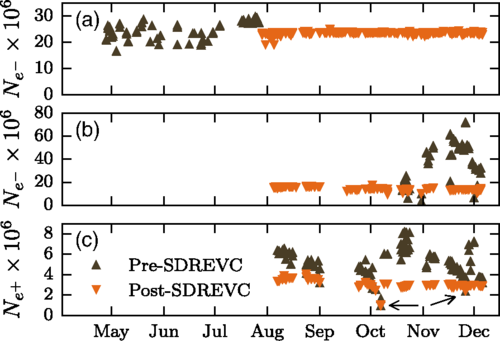Efficient trapping of antihydrogen requires very precise and repeatable manipulation of the antiproton and positron plasmas from which the antihydrogen is synthesized. We were able to greatly increase the efficiency after we developed a new process, SDR-EVC, for stabilizing our positron plasmas. In SDR-EVC, we apply a rotating electric field to the plasma, which sets the plasma density. Simultaneously, we reduce the electrostatic barrier confining the plasma, which sets the plasma charge. Controlling the density and charge fully specifies the plasma parameters.

Graphic 1: Pre-(filled triangle) and post-(filled invert triangle) SDR-EVC measurements:
(a) plasma electron number Ne− in the catching trap;
(b) plasma electron number Ne− in the atom trap; and
(c) plasma positron number Ne+ in the atom trap.
SDR-EVC was implemented at the end of July 2016, so only pre-SDR-EVC data are shown prior to that date. Beginning in August, the pre-SDR-EVC numbers in (a) are off scale. The arrows in (c) indicate instances where the positron moderator efficiency decreased and the number of pre-SDR-EVC positrons dropped below the desired post-SDR-EVC value; the number was recovered by regrowing the moderator.
For more details, see the related publication here.
Source: ALPHA, Enhanced Control And Reproducibility Of Non-Neutral Plasmas, Phys. Rev. Lett. 120, 025001 (2018)
